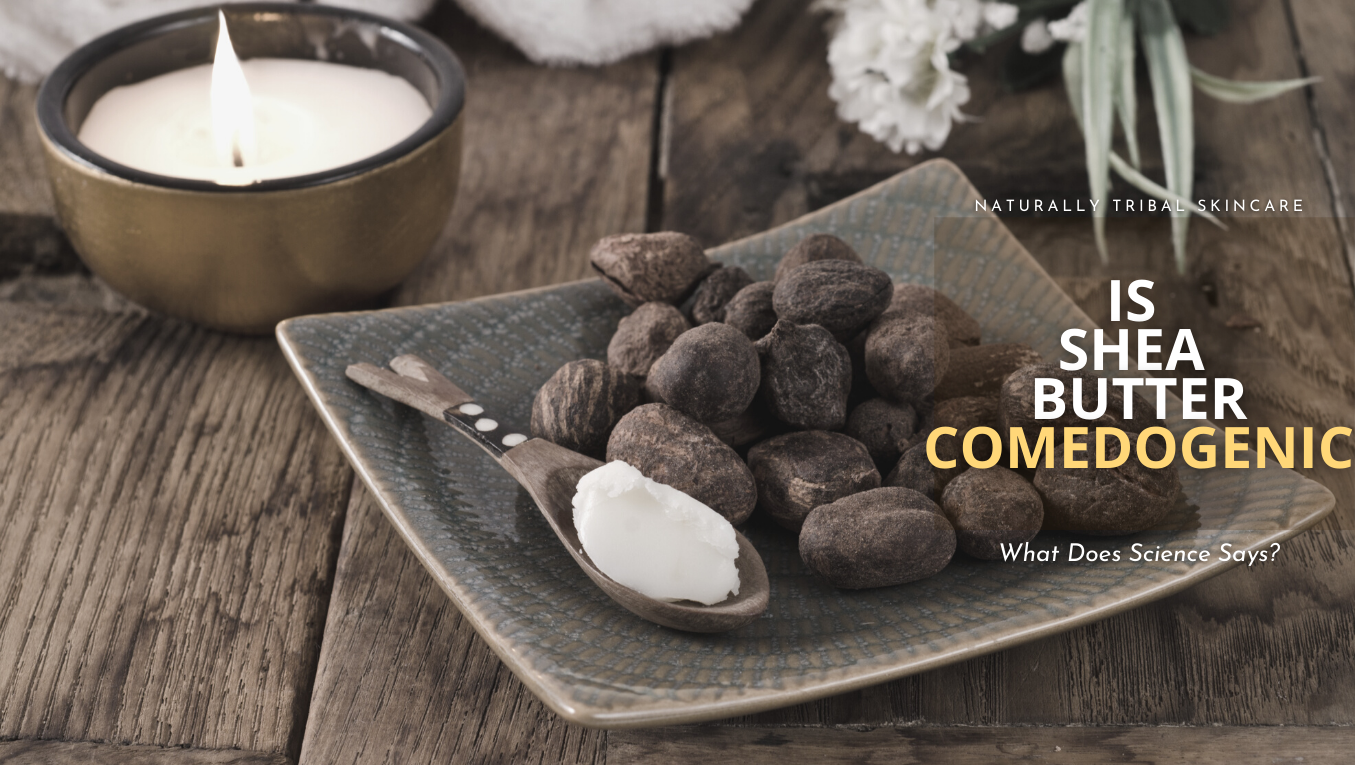Shea butter has been at the heart of my business for over half a decade and after years of working in the global pharmaceutical industry, I know just how important it is to hear what science has to say about shea butter being comedogenic or not.
As a whole, shea butter is not official classified as non-comedogenic. Not enough scientific research has been conducted to establish the comedogenicity of shea butter. However, due to the consistency of shea butter, academic establishments hold the opinion that shea butter is likely comedogenic.
The term “comedogenic” is given to a product or a product ingredient that is likely to clog pores and cause comedones (blackheads).
If you are a person who suffers from bad blackheads or acne, then you are probably always on the lookout for the word “non-comedogenic” when you are investigating a new product.
So, what about the increasingly popular shea butter? With not enough scientific studies done to know for sure if shea butter is comedogenic or non-comedogenic, what should you know?
In this article, we'll look at the likely comedogenic classification of shea butter.
However, I'll also present you with some information on how comedogenicity is determined and the potential problems with this system as it currently stands.

Shea Butter Comedogenicity Has Not Been Scientifically Established
For a substance to be classified as comedogenic, it has to be scientifically proven to clog pores and increase the number of comedones.
Comedogenic testing is not a foolproof science, but we will discuss that in a later section.
No official research has been conducted into the comedogenic effects of shea butter, so we cannot say with any empirical authority that shea butter is either comedogenic or non-comedogenic according to the existing standards.
There are some resources out there that claim shea butter ranks as a zero on the comedogenic scale; in other words, it does not cause pores to clog.
But in light of the lack of scientific research, we wonder where they got this information?
It is probably best to be cautious of the validity of any resources providing you with a comedogenic ranking for shea butter.

Is Shea Butter More Likely To Be Comedogenic Or Non-Comedogenic?
The fact that no one, as of yet, has provided enough scientific research on the comedogenic potential of shea butter means that we cannot officially say if it is comedogenic or non-comedogenic, and we cannot rank it on the comedogenic scale.
However, we can make certain assumptions and extrapolations based on existing knowledge, which can help you to make your decision on whether or not to purchase a shea butter-based product.
The Consistency Of Shea Butter Indicates Comedogenicity
By looking at and feeling the consistency of a product, you can get a fairly good idea of whether it is going to sit heavy against your skin.
Shea butter is just that, a butter. To spread butter over your pores is to create a barrier of oil on the surface of your skin.
Although the healthy oils present within shea butter are filled with nutrients we want for our skin to remain healthy, there is still the possibility that it may affect individuals that struggle with acne regularly.
Professional Opinions About Shea Butter Comedogenicity
The American Academy of Dermatology holds the opinion that shea butter has the potential to clog pores, and by doing so, it has the potential to cause acne.
Additionally, Dr. Herrmann, a dermatologist, mentioned shea butter in a list of oils and butter likely to clog your pores, and she gave the high oleic acid content of shea butter as the reason.
Acne.org also lists oleic acid and cocoa butter (which is a similar constancy to shea butter) as ingredients to avoid for those who struggle with acne.

A Product Containing Shea Butter Might Be Different
A product containing a certain amounts of shea butter will be different from a completely raw shea butter-based product.
While comedogenicity potential is high in the latter, the former might not be a problem for those that struggle with acne.
The following is the conclusion statement in the abstract of a comedogenicity research paper:
“Finished products using comedogenic ingredients are not necessarily comedogenic.”
Problems With The Current Comedogenic Scale
Let’s look at how accurate a comedogenic or non-comedogenic classification for shea butter would be based on the current comedogenic scales that are commonly used to determine comedogenicity.
When a product mentions comedogenicity, you often see it associated with a number. This number refers to where the ingredient falls on the comedogenic scale. The idea is that the higher the number, the greater the comedogenicity.
But there are several problems with the nature of comedogenic testing and the comedogenic scale.
We look mostly at one pivotal research paper, which was published in 2006, to highlight the issues with the comedogenic scale.
This paper was published by the Journal of the American Academy of Dermatology, and it is titled: “A re-evaluation of the comedogenicity concept”.
The Origins Of The Comedogenic Scale Are Based On Animal Models
The comedogenicity scale originated in the 1970s and was based on the comedogenic responses of animals, specifically rabbit ears.
The human studies that followed did not yield the same results, yet people continued to use the scale based on the rabbit ear model.
Now, using animal models to extrapolate human responses is not an uncommon practice in science, and when the American Academy of Dermatology held their 1989 Invitational Symposium on Comedogenicity, they presented their decision with the following wording:
“If the animal model does not show evidence of comedogenesis, the test material under consideration is unlikely to be comedogenic in human skin.”
So, the scale only claimed that a non-comedogenic substance based on the animal model is unlikely to be comedogenic in people.
Still, humans are not rabbits.
Has there been further research? Yes, but these original studies will almost always form part of the foundation of new research, and trials are still conducted chiefly on animals.
The Comedogenic Scale Is Not Standardized
The comedogenicity scale is not actually standardized.
Some use a scale of zero to three, while others use a scale of zero to five.
The 2006 research paper that we are looking at considered a product to be non-comedogenic as long as it caused an increase in microcomedone activity of less than 50%.
In my opinion, if a product causes 49% more blackheads than were there before the product was used, that is not non-comedogenic.
Additionally, the lack of standardization makes it much easier for product companies to make false claims about their products.

Human Trials Have Not Reliably Improved The Validity Of The Comedogenic Scale
The comedogenicity of substances is still being tested on animals, but human trials into comedogenicity are now also taking place.
These trials are not without their flaws, though.
Firstly, the studies are applying the products to the subjects’ backs (link and link). The skin on a person’s back is not going to react the same as facial skin.
At the very least, it has fewer pores and does not receive the same kind of exposure to other products, the sun, air, being touched by hands, etc., as the face.
All of these are what is known in science as confounding variables.
Secondly, individual differences in the severity of reaction to comedogenics were observed, which just goes to demonstrate that comedogenicity is not as straightforward as assigning a number to a product.
Consult A Dermatologist
Ultimately, if you would like to start using shea butter and you suffer from acne, the best thing to do is to discuss this with a dermatologist and introduce the raw shea butter carefully.
Otherwise, if you are just after an oil for the multiple skincare benefits which oils provide, then there are other options for you, and your dermatologist can also provide you with a list of these alternatives if needed.
Comedogenicity is a subject on which scientists will continue to conduct research, and cosmetics and skincare companies will continue to fund this research.
So, one day, there might be conclusive research available about the comedogenicity of shea butter and a more reliable scale available. Until then, however, we have to work with what is available to us.
Existing knowledge indicate that raw shea butter is more likely to be comedogenic than non-comedogenic, so I would recommend trying a product that contains shea butter first before using raw shea butter on your skin.
Our skin is the largest organ of our body, and it needs special care and attention. The problem is that most people aren't taught how to take proper care of their skin, which can result in dryness, itching, or rashes.
Even though there are many products on the market that claim to nourish your skin, they often contain ingredients such as parabens or mineral oil. These ingredients may be harmful to you and your family's sensitive skin.
Naturally Tribal Skincare was created with sensitive skin in mind. Our Body Foods have been specially formulated using Shea Butter to nourish, protect, and moisturize problematic skin without any of the harmful ingredients you might find in other body care brands.
Our products that have been featured in both Forbes and Vogue are 100% natural, making them perfect for use from birth all the way through adulthood!
Click here to learn more about Naturally Tribal Skincare and how we can help your skin.











